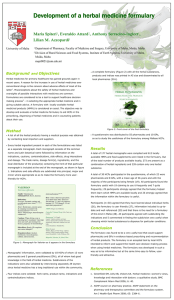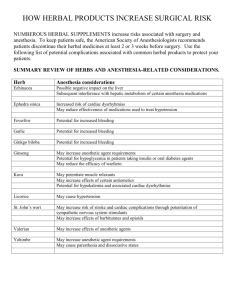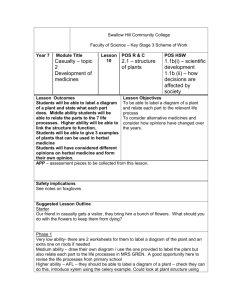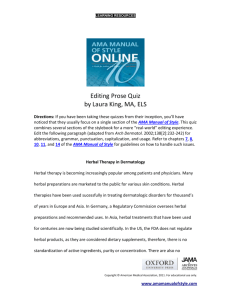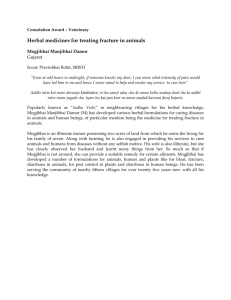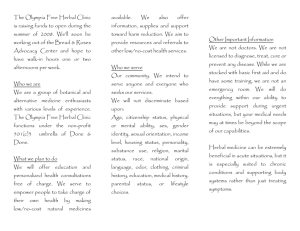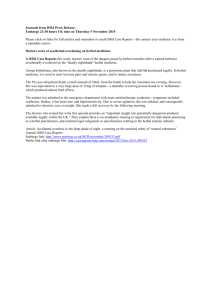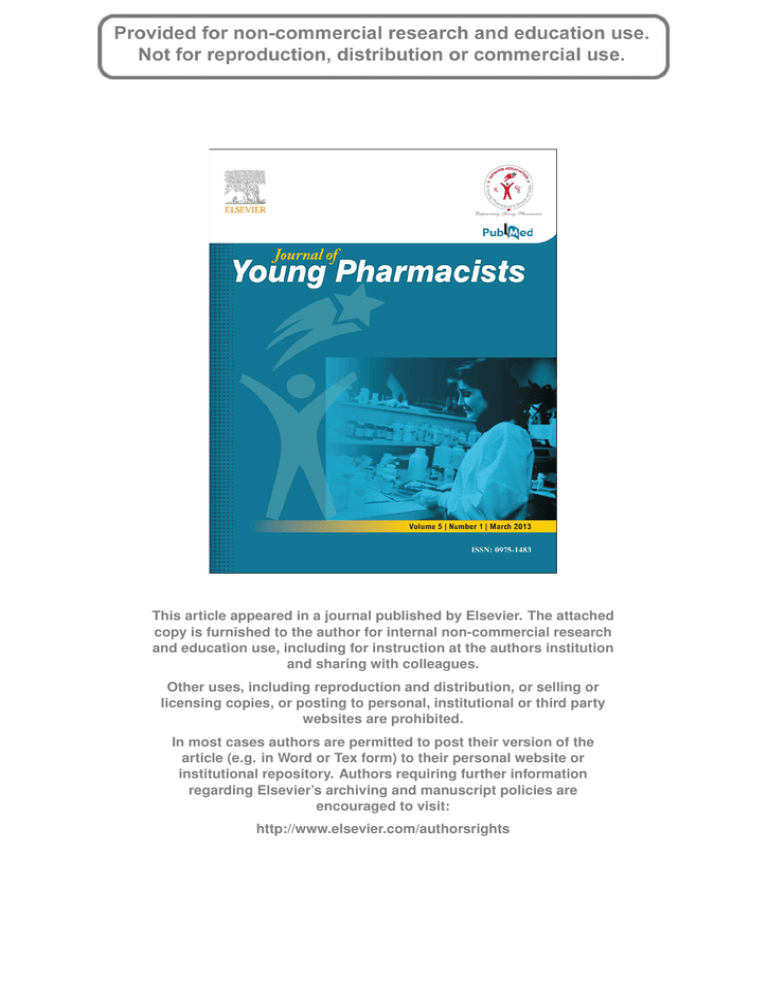
This article appeared in a journal published by Elsevier. The attached
copy is furnished to the author for internal non-commercial research
and education use, including for instruction at the authors institution
and sharing with colleagues.
Other uses, including reproduction and distribution, or selling or
licensing copies, or posting to personal, institutional or third party
websites are prohibited.
In most cases authors are permitted to post their version of the
article (e.g. in Word or Tex form) to their personal website or
institutional repository. Authors requiring further information
regarding Elsevier’s archiving and manuscript policies are
encouraged to visit:
http://www.elsevier.com/authorsrights
Author's personal copy
Journal of Young Pharmacists 5 (2013) 22e25
Contents lists available at SciVerse ScienceDirect
Journal of Young Pharmacists
journal homepage: www.elsevier.com/locate/jyp
Original article
Compilation of a herbal medicine formulary for herbal substances in Malta and its
usefulness amongst healthcare professionals
Maria Spiteri a, *, Everaldo Attard b, Anthony Serracino-Inglott a, Lilian M. Azzopardi a
a
b
Department of Pharmacy, Faculty of Medicine and Surgery, University of Malta, Msida, Malta
Division of Rural Sciences and Food Systems, Institute of Earth Systems, University of Malta, Msida, Malta
a r t i c l e i n f o
a b s t r a c t
Article history:
Received 11 August 2012
Accepted 10 January 2013
Available online 7 March 2013
Context: Today, the use of herbal medicine for primary healthcare has increased considerably. Since local
pharmacists graduate with little knowledge on herbal medicine, the majority are ill-equipped to provide
pharmaceutical advice.
Aims: To develop and evaluate a herbal medicine formulary to aid healthcare professionals (HCPs) in the
prescribing, dispensing and counselling responsibilities.
Settings and Design: Community pharmacies.
Methods and Material: Monographs on all herbal substances available locally were compiled into a formulary. The formulary was then distributed to all, 216, local pharmacies. Subsequently, a questionnaire
was distributed to 55 pharmacists and 10 general practitioners (GPs).
Statistical analysis used: Descriptive statistical analysis.
Results: A total of 177 herbal monographs have been compiled and 612 herbal products listed. Thirty
HCPs participated in the questionnaire. The formulary was found to be useful by all participants with 19
claiming to use it frequently and 7 quite frequently. Participants (n ¼ 30) agree that the information
contained within the formulary was found to be useful (26), the formulary helped them learn which
HMPs are present in the local market (29), the formulary is user friendly (27), information included is upto-date and well referenced (29) and that there is the need for a formulary of this kind in Malta (28).
Conclusions: The formulary was found to be a useful tool for HCPs leading to high quality, evidence-based
prescribing together with enhanced monitoring and improved patient care.
Copyright Ó 2013, InPharm Association, Published by Reed Elsevier India Pvt. Ltd. All rights reserved.
Keywords:
Formulary
Healthcare
Herbal medicine
Pharmacist
Usefulness
1. Introduction
Herbal medicine is one of the oldest forms of healthcare known
to man.1 It has a very long history, going back to the beginning of
civilization.2 For many years, Malta, like many other countries, used
herbal medicine as the only form of medication making herbalism
an integral part of the way of life of the Maltese society at the time.3
Herbal medicine at its origin was a phenomenon of both
developed and undeveloped countries.4 With the arrival of modern
synthetic drugs, about 100 years ago, medical herbalism was rendered almost extinct in countries like UK and USA. In other countries like India, China, and Germany, medical herbalism continued
to play a role but did not remain the focus of every day used
medications.5 Medical herbalism is coming back into focus once
* Corresponding author.
E-mail address: mspi0021@um.edu.mt (M. Spiteri).
again, and at present, 80% of the world populations use complementary medicine for primary healthcare.6,7
Currently, HMPs in Malta are mainly sold from pharmacies. Due
to augmenting demands for HMPs by Maltese consumers, more
pharmacists are stocking natural health products in their pharmacies. However, together with an increase in sales of HMPs, there
is an increase in the number of consumers’ inquiries with such
consumers looking to pharmacists for evidence-based information.8e13 A significant intervention of a pharmacist today is to
provide pharmaceutical advice,14 but many pharmacists appear to
have little knowledge on natural health products, making them illequipped to implement this key recommendation.
Formularies are an effective way to improve prescribing practice,14 and the concept of formularies forms a basis of modern
management systems.15 There are virtually no sources of referenced information regarding herbal therapy that are specific to
products available in local community pharmacies. The study
aimed at developing and evaluating a formulary of herbal medicinal products available in local pharmacies.
0975-1483/$ e see front matter Copyright Ó 2013, InPharm Association, Published by Reed Elsevier India Pvt. Ltd. All rights reserved.
http://dx.doi.org/10.1016/j.jyp.2013.01.003
Author's personal copy
M. Spiteri et al. / Journal of Young Pharmacists 5 (2013) 22e25
2. Materials and methods
This study, leading to the compilation of a local herbal medicine
formulary, assembled alphabetically according to the common
names of the herbal substances, consisted of three main phases: (i)
compilation of monographs for herbs and their validation, (ii) organization of relevant indices and printing of a complete formulary,
and (iii) distribution of the formulary to all local pharmacies and
evaluation of its usefulness.
2.1. Data collection
The preliminary phase was to obtain an exhaustive list of HMPs
available on the local market. Four pharmacies were visited to
study the different brands available locally. Local distributors were
then contacted so as to develop a complete list of products for every
brand. The products’ list was narrowed down to HMPs, borderline
substances, and food supplements, all of which contain herbal
ingredients.
A thorough literature search for the active ingredients of each
product was then carried out, either through the products’ electronic site of the brand or by visiting pharmacies and reading on the
package or package insert, such that another list was compiled.
After having finalized a list of: (i) all the herbal products available
on the local market and (ii) all the herbal ingredients present in the
products mentioned above, various literature sources namely
books, peer-reviewed articles in journals, and reliable internet sites
were referred to, so as to initialize the compilation of the monographs on every herbal ingredient.
2.2. Formulary compilation
Monographs for all herbal substances were formulated. Every
herbal monograph has stated the herbal common name (the title of
the monograph), Latin binomial and the family and medicinal
part(s) of the herb in question. Information on the indications
(subdivided into principal, major, minor, and others were appropriate), cautions, contraindications, side-effects, drug interactions,
and dosage follows. Each monograph ends with products containing that particular herb. Product information includes the trade
name, brand, dosage form(s), active ingredient(s), and the name of
the local distributor. Full product information is listed only once
under the herb present in the highest dose within the product. The
trade name and brand are then listed again under every herb present as part of the active ingredients and the reader is referred to the
monograph under which the full product information is located.
The compiled monographs were handed over to 18 healthcare
professionals (HCPs) of which 13 were pharmacists and five general
practitioners (GPs), all of which have good knowledge or specialization in the field of herbal medicine, so as to validate monographs’ information, giving particular attention to the indications.
This validation exercise was essential since there is no published
work stating clearly which indications are the principle, major, or
minor. Twenty-nine laymen were also interviewed separately in
pharmacies and health food shops and were asked for which indications they use the product(s) they would have just bought. This
validation phase of the study was set up to verify the accuracy of
the subdivisions of the indications and also to verify the effectiveness of the formulary.
Meanwhile, a total of four indices were collated: Herb name,
product name, indications, and contraindications indices. The latter
two were constructed by first inputting all the data in Microsoft
Office Excel 2007 and then transferring the data into Microsoft
Office Access 2007 to create queries and generate reports
accordingly.
23
A complete formulary containing all the herbal substances and
HMPs available locally was printed and disseminated in all, 216,
local pharmacies. A questionnaire was distributed to 55 pharmacists and 10 GPs, irrespective of their knowledge on herbal medicine. Stratified sampling was adopted by subdividing the country
into six districts. Its aim was to study the usefulness of the formulary amongst Maltese HCPs.
Microsoft Office Excel was used for the statistical analysis. All
numerical determinations were analyzed using descriptive statistical tools with frequencies. Results were expressed as means, and
only P < 0.05 was considered significant.
3. Results
A total of 177 herbal monographs have been compiled and 612
herbal products listed. Out of the total number of products listed,
273 are present as a combination of herbal ingredients and 339
contain only one herbal substance.
Korean ginseng is the herb having the largest number of products listed within its monograph: 38 products are imported locally,
whether in combination or containing Korean ginseng as the sole
ingredient (P < 0.05, n ¼ 1194 entries). This is followed by ginkgo,
green tea, aloe, and echinacea with 36, 35, 33, and 27 products each,
respectively. Only 16% of the herbs (n ¼ 153) feature in monocomponent products.
The most common indication that is referred to by the majority
of the herbal substances is bronchitis. It is found mentioned in the
indications of 41 species. This is followed by rheumatism, asthma,
diarrhea, loss of appetite, and hemorrhoids which are present in 28,
26, 24, 23, and 22 species, respectively. The majority of the indications, 587 out of a total of 812 distinctive indications, are only
stated in the monograph of one species.
From all the herbal substances listed in the formulary, olive is
the herb having the greatest number of indications, with 25 different indications appropriate for its usage (P < 0.05, n ¼ 177). This
is followed by garlic with 23 indications and starflower, marigold
and bilberry each having 21 indications. Six species: Tragacanth,
senna, gamboge, yohimbe, kidney bean, and sorrel, have two indications each listed in their monograph. Only one herb, Hoodia, is
used for a single indication, this being appetite suppression.
The commonest contraindication is pregnancy, stated for 79
species. Breast-feeding and stomach ulcers follow, being contraindicated in 29 and 11 species, respectively. The absolute majority
of the contraindications, 92 out of a total of 134 distinct contraindications, are each mentioned in only one species.
A total of 30 HCPs participated in the questionnaire, of which 22
were pharmacists and eight GPs, with a mean age of 36 years and
with the majority of the participants being females (19). All participants found the formulary useful with 19 claiming to use it
frequently and seven quite frequently [Fig. 1]. All the participants,
except one, strongly agree with the fact that the formulary helped
Fig. 1. How often the formulary was used per week (n ¼ 30).
Author's personal copy
24
M. Spiteri et al. / Journal of Young Pharmacists 5 (2013) 22e25
Fig. 2. Formulary helped in gaining knowledge on the locally available products
(n ¼ 30).
them learn which HMPs are present in the local market [Fig. 2], and
26 strongly agree that the information contained within the formulary was found to be useful [Fig. 3].
Participants (n ¼ 30) agree that they have learned about individual herbs (26), the formulary is user-friendly (27), information
included is up-to-date and well referenced (29) and that there is
the need for a formulary of this kind in Malta (28). All participants
agreed with subdividing the indications, and five commented on
finding these subdivisions very useful and helpful when choosing
which herbal substances to dispense for particular conditions.
4. Discussion
This study aimed to compile a formulary system that will ultimately help HCPs have a clear view of the herbal substances that
are available for treating patients. All the participants that took part
in the questionnaire found the formulary useful and helpful. The
usefulness of the formulary is also evident from the high frequency
of usage. Only four of the participants used the formulary rarely,
possibly due to lack of patients making use of herbal products in
specific areas. Frequency of usage varies between pharmacists and
GPs but has no correlation with the age of participants. The four
participants who rarely used the formulary were all GPs. A good
number of herbal products are bought over-the-counter, and
patients prefer to go directly to the pharmacist rather than visiting
a doctor when they prefer to have an herbal medication.
Korean ginseng is the most popular herb amongst the Maltese
community since it is the herb having the greatest number of
products imported locally. Ginseng ranks 26th on the traditional
use registration (TUR) list provided by the European Medicines
Agency.16 The TUR, amongst other parameters, indicates the
quantity of medicinal products used in the EU. This low ranking
may be attributed to the fact that most ginseng products are food
supplements rather than herbal medicines. Ginkgo and green tea
are the two other leading popular herbs in Malta. These three herbs
have a common use, namely cardiovascular diseases. Coronary artery disease and stroke are the leading causes of death in both men
and women and are also important causes of morbidity in Malta.17
This points to a possible explanation to why Korean ginseng,
ginkgo, and green tea are the most popular herbs locally.
Amongst the six most mentioned indications in the formulary’s
monographs, bronchitis and asthma are related conditions. Cough
is another symptom related to the latter two conditions, ranking as
the 10th most mentioned indication. Eight herbal substances
(dquai, brahmi, wood betony, sundew, ephedra, grindelia, hyssop,
and mullein) can be used for asthma and bronchitis; three (grindelia, hyssop, wood betony) can be used for all the three conditions.
Grindelia and hyssop are specific for treating such conditions since
these indications are listed as ‘principal’ or ‘major’; wood betony
lists them under ‘others’ indications. The European Medicines
Agency reports that 17% of the TUR products (n ¼ 785) and 25% of
the well-established use (WEU) products are registered or
authorized for use in cough and cold conditions.18
Different herbal substances vary in the number of indications
they can treat or prevent. Herbal substances having an extensive list
of indications are very often non-specific in treating particular
conditions. This justifies the need to classify such indications as
‘principal,’ ‘major,’ ‘minor,’ and ‘others’. Herbs having few indications are often more specific. Tragacanth, senna, and gamboge
all have only two indications each. They are all primarily used for
constipation, showing specificity in treating such a condition.
Aloe vera has been debated for its status, as whether it is a HMP
or a food supplement. Today, there is a clearer distinction between
aloe products as the presence of anthraquinone glycosides distinguishes whether the product is a medicine or not. Yohimbe and
cascara are both considered as HMPs. Therefore, the fact that these
products should be used with care, due to their indications and
contraindications, they qualify as HMPs rather than food
supplements.19
The fact that several herbal products are contraindicated in
pregnancy may be due to the very few studies reporting the effects
of herbs in pregnancy and in most cases, the statement ‘the use of
this herb in pregnancy has not been reported’ is common to many
products found in the formulary. The same is observed with breastfeeding though this is given less importance than pregnancy. As
regards to stomach ulceration, especially for orally administered
herbal products, the first site of contact is the stomach.20 Therefore,
the effect would be a possible immediate observation when compared to effects on other organs.
The presentation of the formulary was greatly accepted by all
participants, making it more probable for HCPs to use it. In fact, 19
(63%) participants said that they used the formulary frequently and
seven (23%) quite frequently.
The classification of herbal medicinal products21 and subsequently sub-classes, traditional HMPs, and herbals with a wellestablished use,22 has been a priority to the European Medicines
Agency. The agency, a body of the European Union, has published
several herbal monographs, through its Committee on Herbal
Medicinal Products (HMPC), in order to clarify the status of certain
herbal products for the European market.23
The transposition of the Herbals Directive (2004/24/EC)24 and
its subsequent amendments in all member states is a lengthy
process. Within this transition, the formulary will assist local authorities and HCPs on the presence of herbal products available on
the Maltese market.
5. Conclusion
Fig. 3. Usefulness of information contained within the formulary (n ¼ 30).
The formulary was found to be a very useful tool that supports
pharmacists and GPs in evidence-based prescribing and recommendation of herbal products. The formulary is an accepted tool by
the local HCPs, and its aim to inform and support the healthcare
decision-making process has been reached. HCPs are provided with
knowledge on a limited range of natural medications, resulting in
enhanced monitoring of drug therapy and improved patient care.
Author's personal copy
M. Spiteri et al. / Journal of Young Pharmacists 5 (2013) 22e25
The formulary was developed in such a way as to be informative but
at the same time easy to follow, user-friendly, and attractive. Since
the available products are changing continuously, with some being
newly introduced and a lot others being discontinued, there is the
need for frequent updates. Formularies require constant evaluation
and should be updated regularly so as to remain an efficient tool for
modern management systems. With the increase in IT equipment,
including tablets and smartphones, the launching of the formulary
in an electronic format may be a possibility. This will facilitate
updates and improvements in the final product when needed.
Conflicts of interest
All authors have none to declare.
References
1. Atmakuri LR, Dathi S. Current trends in herbal medicines. J Pharm Res. 2010;3:
109e113.
2. Chong’s Health Care Enterprise, Inc. History of Herbal Medicine, Alternative
Medicine, Medicinal Herbs [Online] [Last cited on 2011 Feb 03]. Available from:
http://www.herbpalace.com/alternative-medicine/herbal-medicine.html; 2003
Accessed 15.01.13.
3. Zammit Montebello M. Herbal Remedies [Project]. Msida (Malta): Department of
Pharmacy, University of Malta; 1988.
4. Gossell-Williams M, West ME. The past and present use of plants for medicines.
West Indian Med J. 2006;55(4):217e218.
5. Ernst E. Herbal Medicine e A Concise Overview for Professionals. Oxford: Butterworth-Heinemann; 2000.
6. Iqbal Choudhary M, Mosihuzzaman M. Protocols on safety, efficacy, standardization, and documentation of herbal medicine. Pure Appl Chem. 2008;80:2195e2230.
7. Aneesh TP, Revikumar KG, Sekhar MS, Varghese KJ, Vasudaven DT. Herbalism:
a phenomenon of new age in medicine. Int J Pharm. 2008;6:8.
8. Austin Z, Boon H, Eccott L, et al. Canadian pharmacy students’ knowledge of
herbal medicine. Am J Pharm Educ. 2008;72:75.
9. Bryant PJ, Clauson KA, McQueen CE, Shields KM. Knowledge and attitudes of
pharmacists in Missouri regarding natural products. Am J Pharm Educ. 2003;67:41.
25
10. Chang ZG, Holdford DA, Kennedy DT, Small RE. Pharmacists’ knowledge and
attitudes toward herbal medicine. Ann Pharmacother. 2000;34:710e715.
11. Dolder C, Dolder N, Gregory P, Lacro J. Pharmacists’ use of and attitudes and
beliefs about alternative medicine. Am J Health Syst Pharm. 2003;60:1352e1357.
12. Hadsall RS, Schommer JC, Welna EM. Pharmacists’ personal use, professional
practice behaviours, and perceptions regarding herbal and other natural
products. J Am Pharm Assoc. 2001;43:602e611.
13. Cauffield JS, Chin TW, Harris IM, et al. White paper on herbal products. Pharmacotherapy. 2000;20:877e891.
14. Bissell P, Blenklnsopp A, Mason L, Short D. Patients’ experiences of a community pharmacy-led medicines management service. Health Soc Care Comm.
2008;16:363e369.
15. Khan F. Using medicines wisely e the place of the formulary in medicines
management. Hosp Pharm. 2002;9:159e163.
16. European Medicines Agency. Uptake of the Traditional use Registration Scheme
and Implementation of the Provisions of Directive 2004/24/EC in EU Member
States; 2011. EMA/322570/2011 Rev. 1.
17. Ministry for Health, the Elderly and Community Care. A Strategy for the Prevention and Control of Noncommunicable Diseases in Malta. Malta: Progress
Press Company Ltd.; 2010.
18. Ling AM. FDA to ban sales of dietary supplements containing ephedra. J Law
Med Ethics. 2004;32:184e186.
19. European Medicines Agency. Guideline on Declaration of Herbal Substances and
Herbal Preparations in Herbal Medicinal Products/Traditional Herbal Medicinal
Products [Online] [Last cited on 2012 Jul 23]. Available from: http://www.
ema.europa.eu/docs/en_GB/document_library/Scientific_guideline/2009/09/
WC500003272.pdf; 2010 Accessed 15.01.13.
20. Coboeken K, Dressman JB, Lippert J, Thelen K, Willmann S. Evolution of
a detailed physiological model to stimulate the gastrointestinal transit and
absorption process in humans, part II: extension to describe performance of
solid dosage forms. J Pharm Sci. 2012;101:1267e1280.
21. Attard E. Herbal medicine: a legal persective. Synapse. 2011;1:11.
22. Attard E. Herbal medicinal products e the two sides of the coin. Synapse.
2011;2:15.
23. European Medicines Agency. Human Medicines e Herbal Medicinal Products
[Online] [Last cited on 2012 Jul 23]. Available from: http://www.ema.europa.eu/
ema/index.jsp?curl¼pages/regulation/general/general_content_000208.jspand
mid¼WC0b01ac05800240cf; 2012 Accessed 15.01.13.
24. Directive 2004/24/EC of the European Parliament and of the Council of 31
March 2004 amending, as regards traditional herbal medicinal products,
Directive 2001/83/EC on the community code relating to medicinal products
for human use. Official Journal of the European Union. 2004;136:85e90.



